In an industry renowned for precision, sterility, and seriousness, one company is boldly rewriting the rules with dinosaurs, humor, and viral stunts.
Welcome to the world of Plasmidsaurus—where marketing is deliberately playful, memorably quirky, and irresistibly engaging. But how exactly does a biotech company thrive by being intentionally unconventional?
Let’s dive in.
The story of Plasmidsaurus
Plasmidsaurus was founded in 2021 from the merger of two sequencing businesses, Primordium Labs and SNPsaurus, which were largely doing the same thing: providing on-demand plasmid sequencing as a service.
Plasmid sequencing is a big thing in biotech, as 1 in 25 samples has some form of error in their sequences and thus will not produce the expected result. To solve this, scientists need to sequence their plasmids to ensure that they are usable.
But sequencing isn’t so easy without the right equipment and training and that’s why several companies like Plasmidsaurus started offering their sequencers on demand.
Their process is simple:
- Customers mail their plasmids and pay a small fee (~$15).
- Plasmidsaurus sequences them using nanopore technology.
- Results are delivered within a day.
Unlike traditional sequencing providers, their service is fast, cheap, and hassle-free, which is reflected in their branding: fun, simple, and highly engaging.
There is an amazing article on the business model of Plasmidsaurus written by Abhishaike Mahajan on his blog. This article already covers most of the company’s history, its competitive advantage and why this business is so relevant, so for the purposes of this article, I will not go into too many of those details and will just focus on studying their marketing strategy.
Plasmidsaurus’ marketing strategy
Plasmidsaurus takes a deliberately unorthodox approach to biotech marketing. Instead of polished corporate branding, they embrace absurdity through humor, playful branding, and viral content, using a strategy commonly known as unhinged marketing.
Could you imagine a biotech company sharing drawings of dinosaurs as their main marketing collateral? Well, they do, and that’s not even the craziest thing they did.
One of the reasons why this works is because they are consistent with this branding on all channels but still adapt to the identity of the channel they are using in subtle ways.
In this section, I’ll show you how they do it.
Website
Plasmidsaurus’ homepage is extremely efficient. There is no superfluous, just straightforward value propositions from the top to the bottom. Here is their hero (homepage section above the fold):
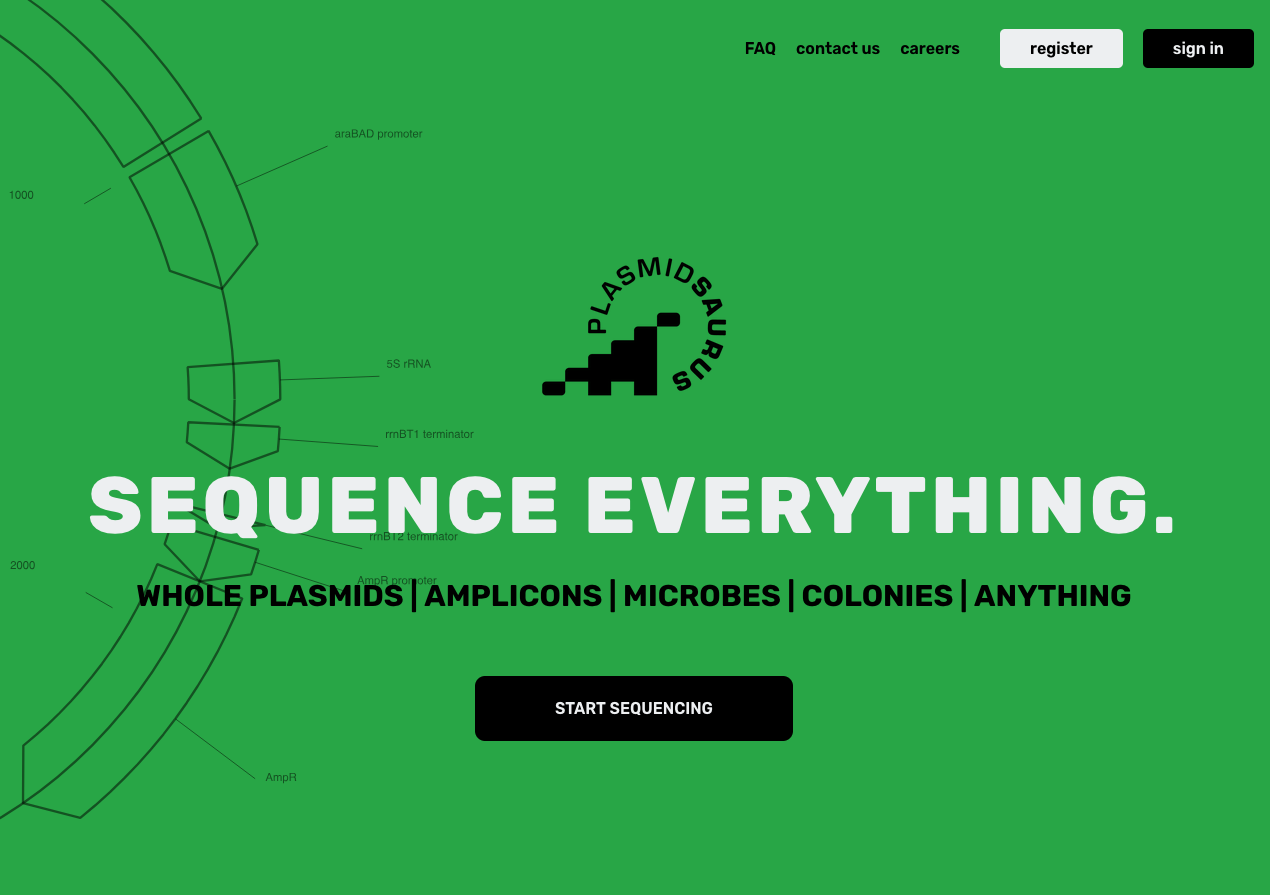
It’s just clean, simple, and you immediately get what they are offering.
Just compare this to a competitor’s homepage, like Novogene:
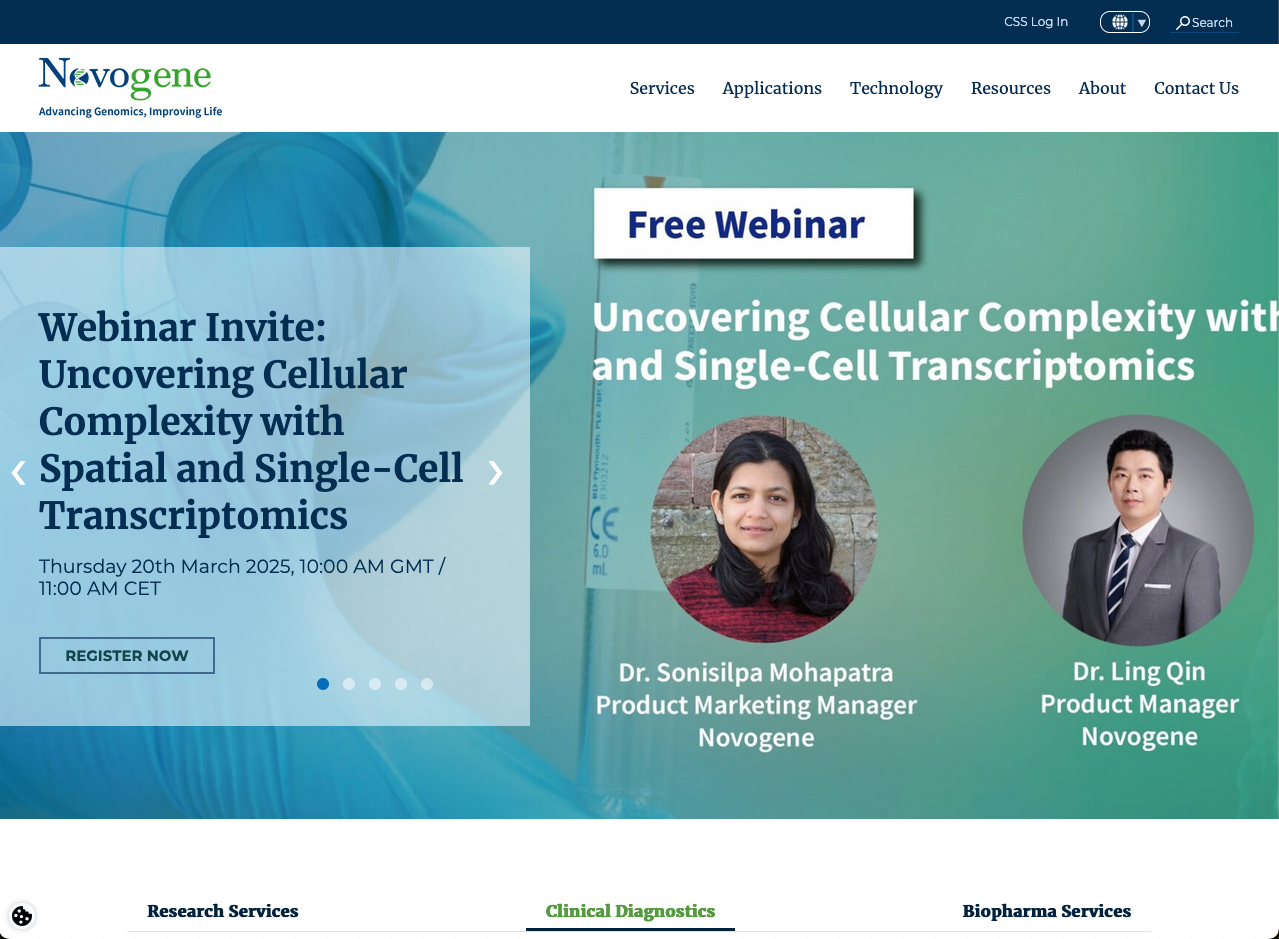
This website, on the other hand, is cluttered, difficult to navigate, and worst, it’s really hard to get what this company is doing if you don’t scroll down, or navigate the slider.
One thing to notice about Plasmidsaurus’ homepage is how they adapt to the audience visiting this channel. The dinosaur-theme marketing is kept to a low profile on the website, which makes sense because people can come from anywhere and might be put off if they are not already familiar with the company’s obsession with dinosaurs.
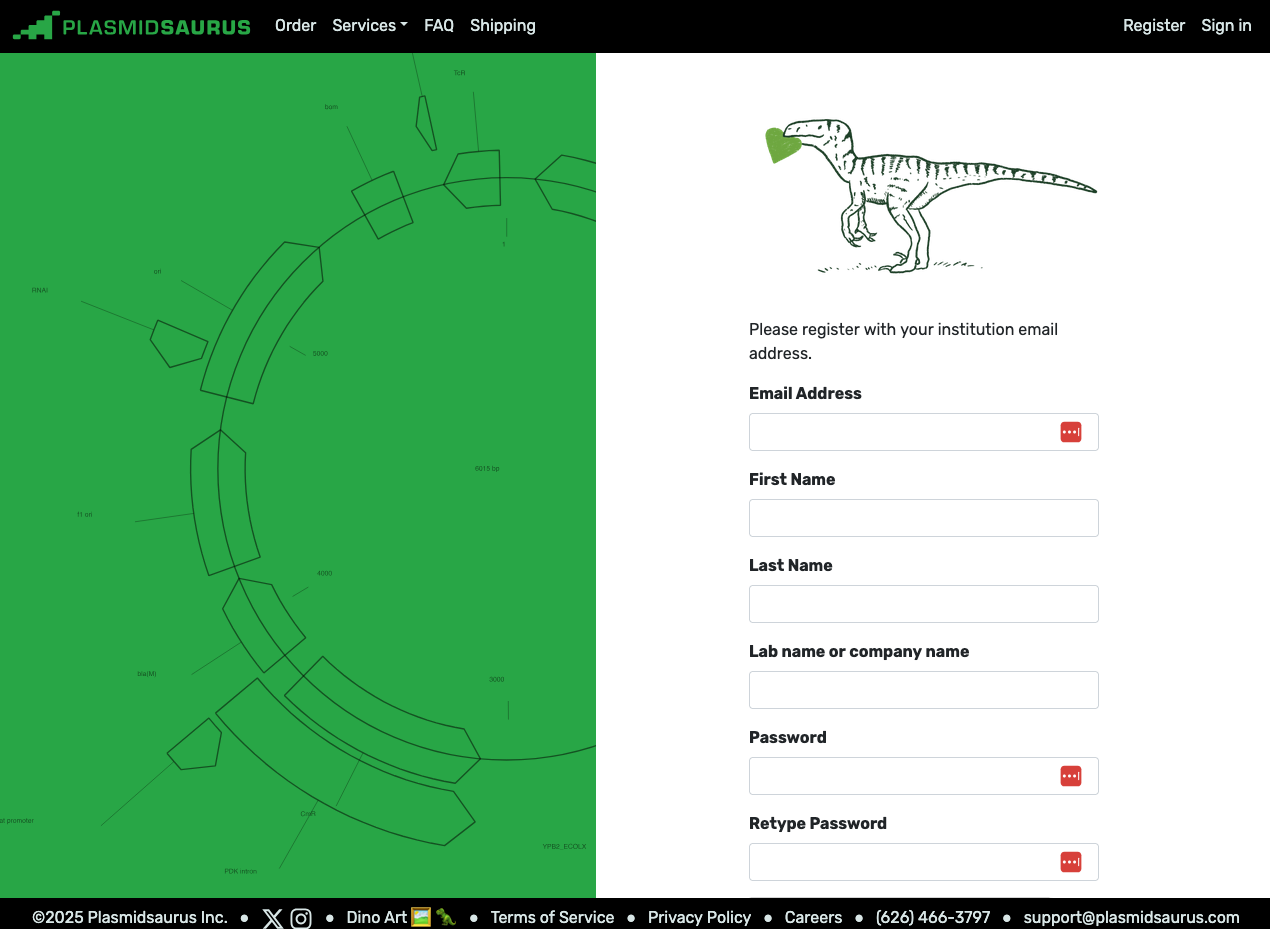
They still keep a “Dino Art Gallery” accessible in the footer, but you can easily miss it if you’re not looking for it.
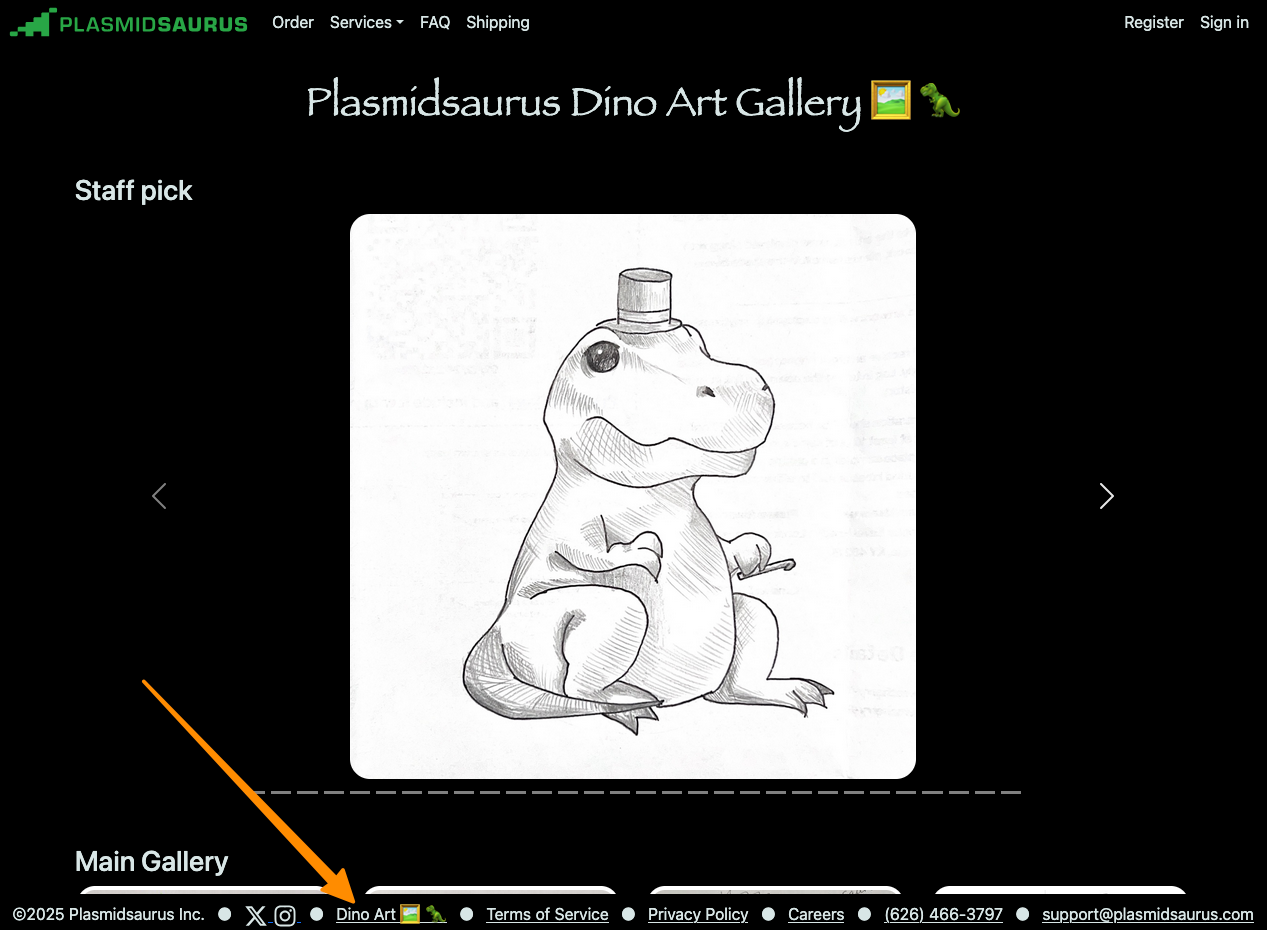
While the website stays more conventional, things start to get weirder as soon as you visit their social media pages.
Social media
Plasmidsaurus’ Instagram and X accounts are a collection of hand-drawn dinosaur sketches—no traditional product promotions, no technical infographics, just dinosaurs.
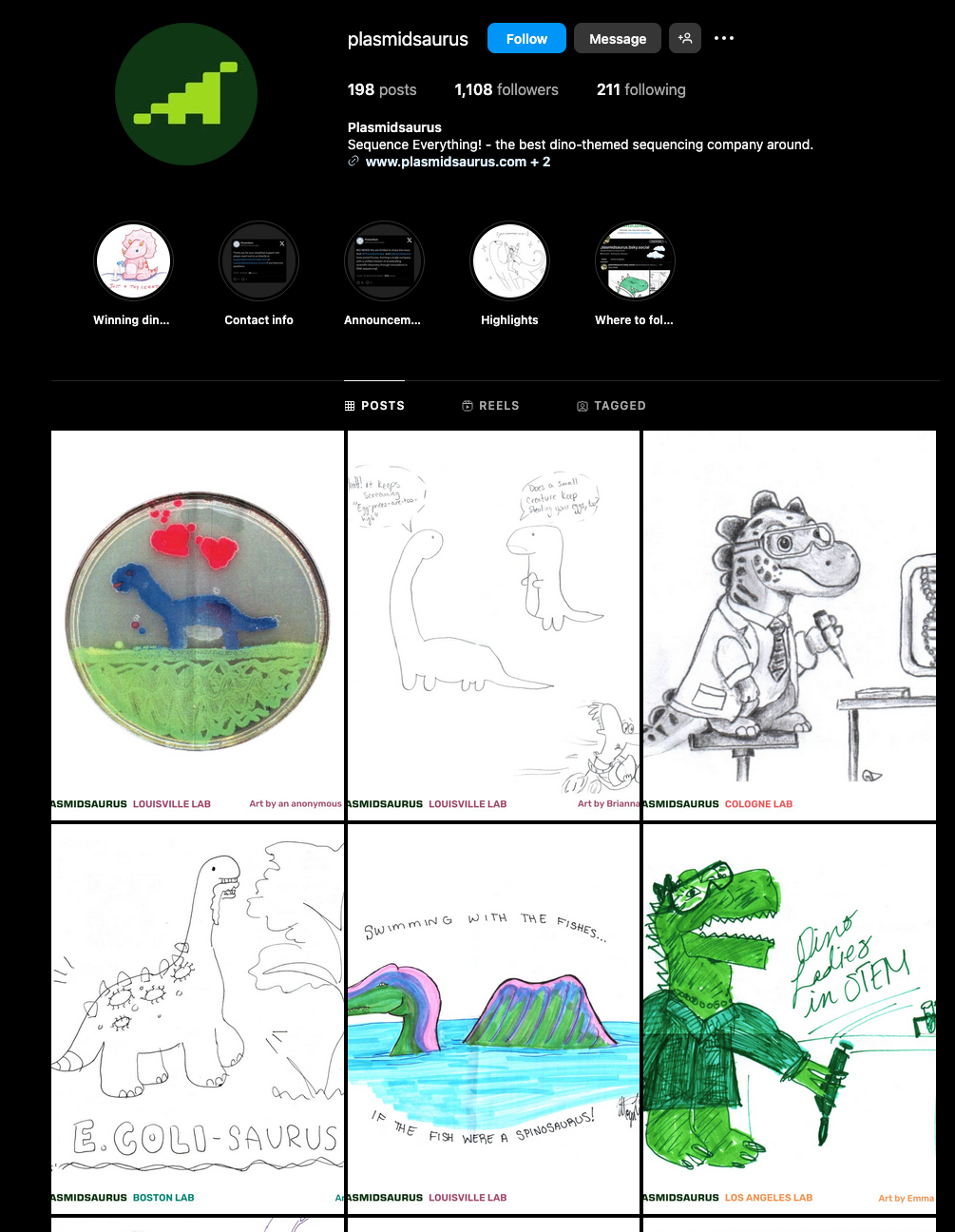
Why would they do it? Because they know that scientists on those channels are more likely to be in a less serious mood, and everyone loves a good dinosaur drawing anyway. So instead of trying to sell something, this tactic aims at creating a community around a simple idea: scientists sharing dinosaur drawings.
If you compare it to their LinkedIn page, the tone is much more attenuated, which makes sense as people would not react the same to dinosaur drawings on this channel.
But still, they’re not leaving their humor behind. Ten months ago, they posted this video of a guy in a dinosaur suit doing BMX stunts in the middle of Oxford:
The goal was to announce a new lab opening in London, but what’s really impressive is that they managed to get actual scientists on board with their idea, including the likes of a group leader at Oxford's Centre for Immuno-Oncology.
At the beginning of the year, they did it again, this time in Seattle (renamed “Cell-Attle” for the occasion):
The first video is actually how I came across this company, and I have never forgotten them since, so you can say the intention worked.
Offline marketing
Plasmidsaurus doesn’t stop at online marketing, they also do offline marketing with the same kind of absurdity and humor.
Here’s an example of a dino-themed cereal box they gave around at a conference:
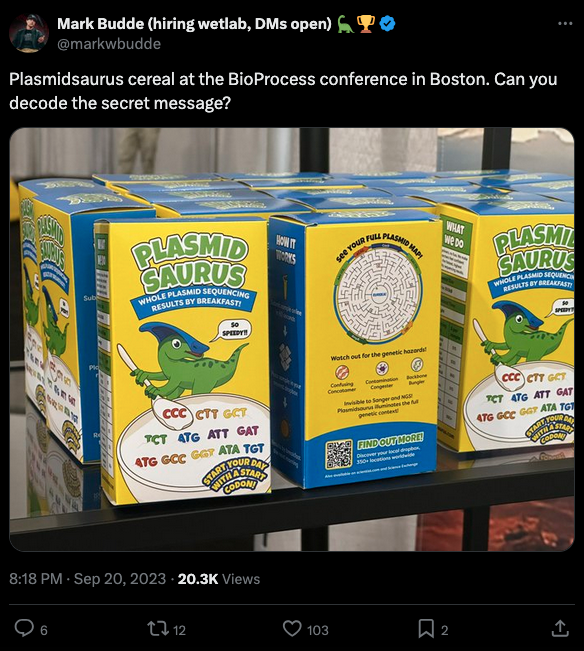
This is pure genius. Biotech conferences are usually a very serious affair, and most exhibition booths lack originality, so seeing something like this in the middle of a boring floor will instantly draw attention.
Again, consistency is key here. If Plasmidsaurus went to a conference and brought a booth that looked like any other, they would immediately lose their edge, but instead of playing it safe, they found an original way to engage visitors.
I mean, the event organizer must love them for that, I’m sure everything people could remember from this event was the crazy cereal boxes!
So now that you get the idea of what unhinged marketing is, let’s see how it impacts their target audience.
Leveraging community-driven marketing
One of the most powerful aspects of Plasmidsaurus’ marketing is that their customers do most of it for them.
You just need to look at Reddit to see a bunch of scientists constantly recommending Plasmidsaurus over competitors:
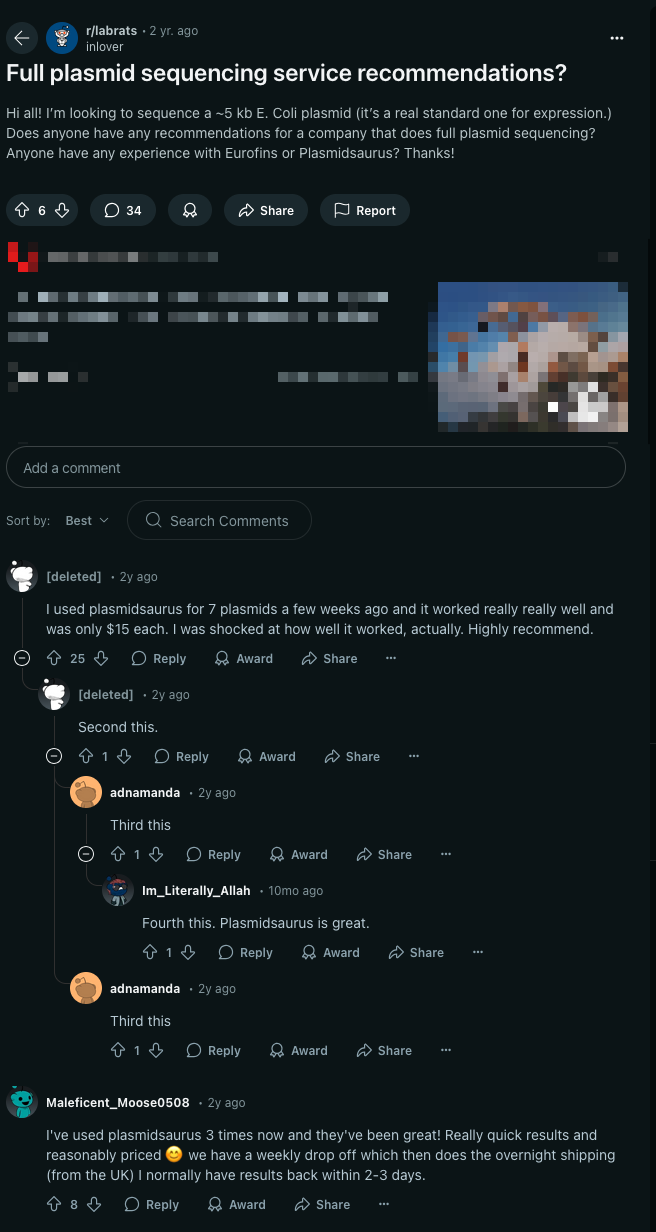
The fact that people are so enthusiastic about this company is, of course, because their service is of great quality, easy to use, cheap and fast. But the friendly aspect of the brand makes it much easier to align with them over the competition—which translates to free word-of-mouth marketing.
I think Plasmidsaurus understands this well. Going back to their homepage, you just need to scroll below the hero to see one of the best social proofs I’ve ever seen for a life sciences company:
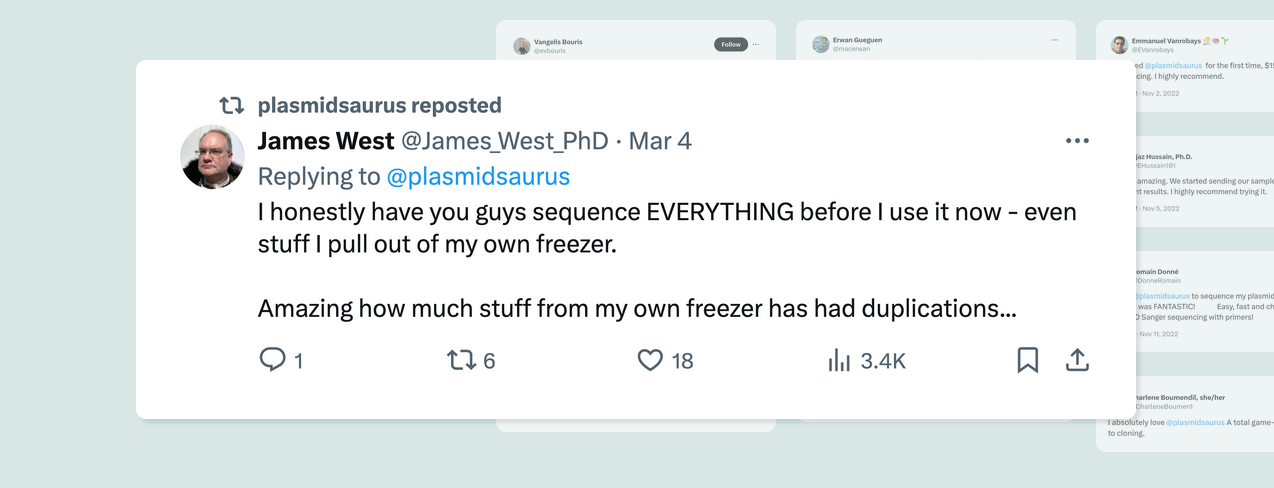
Website testimonials in life sciences are usually the dull type of someone saying, “This company is great, the team is professional and completed the work on time, blablaba”. But this social proof is a tweet, so it’s much more authentic and impactful, and most importantly, it feels real and not like just another quote that had to be taken by force.
You can also see many other tweets in the background, suggesting that this is not an isolated incident, but just one of many public statements in favor of the company.
Word-of-mouth is often underestimated, but in an industry like life sciences, where words can travel very far into the niche, it's certainly one of the most powerful marketing forces, and Plasmidsaurus has got it right.
So now, let's explore how this kind of marketing works on our brains.
How does unhinged marketing influence us
Unhinged marketing is an unconventional strategy that uses boldness, humor, and unpredictability to capture the attention of audiences. Unlike traditional marketing, which often adheres to polished and predictable narratives, unhinged marketing embraces spontaneity and relatability, or even absurdity.
This type of marketing triggers a number of cognitive biases that we can't avoid:
- Novelty bias: We instinctively pay attention to what's new, strange, or unusual. Visual novelty, like a biotech company sharing a drawing of a dinosaur, creates a curiosity gap that we must fill by exploring further. It's basically a great attention grabber that most companies can't replicate.
- Confirmation bias: People respond strongly to marketing that confirms their existing beliefs, even if they are exaggerated or absurd. For example, if you are a scientist who believes that most service providers are boring (in other words, you are part of the norm), then you will instinctively align yourself with a brand like Plasmidsaurus that promises to add some fun to your day.
- Humor effect: Let's not forget that this whole dinosaur shenanigan is fun and makes us laugh. Result: We lower our barrier and are more inclined to spend our lab grants without thinking too much, especially when the sequencing only costs $15.
- Bandwagon effect: People adopt ideas because they see others embracing them, even if they're unconventional or controversial. I've shown above how people share Plasmidaurus references on many channels, but in addition to virality, this creates a kind of insider group that can relate to each other.
- Isolation effect: This is a more subtle bias than the others and is due to the fact that items that stand out strongly from their context are more memorable. In this case, the dinosaurs have no relationship to the sequencing service, which actually makes the association more memorable. What's great is that the brand name Plasmidsaurus is a combination of the two concepts: on one side, the context (plasmids), and on the other side, the thing to remember (dinosaurs).
This marketing approach has gained traction in the last decade, especially among younger demographics who value brands that are authentic, humorous, and willing to draw on memes and codes from internet culture. Here’s a great article on the history of unhinged marketing if you want to dig deeper.
This kind of marketing reminds me of the crazy marketing stunt surrounding the language learning app Duolingo in recent months and the fact that they decided to kill their own mascot, the owl Duo (here’s a hilarious video of the CEO announcing the death). The video and its following announcement (like the fact that Duo faked its own death) went completely viral and now have millions of combined views. The reason it works is the same as with Plasmidsaurus and their dinos, and Duolingo has mastered it to the point of being today the company synonymous with unhinged marketing.
So, should you replicate this strategy? Sorry to destroy your dreams of going viral, but for once, I’ll recommend you NOT to do the same. Let’s explore why.
Why unhinged marketing works for Plasmidsaurus, but not for you
Covering Plasmidsaurus as a case study was kind of a paradox for me. It’s by far the most original marketing case study in the whole of life sciences (yes, I’m not doubting it any second), but it’s also something most companies can’t replicate, and for a good reason: it would backfire at them!
Plasmidsaurus has been doing this type of marketing forever and it is anchored in their company DNA (no pun intended).
Dinos are literally everywhere in their company. I mean, they even have an actual (kind of) living dino in their office:
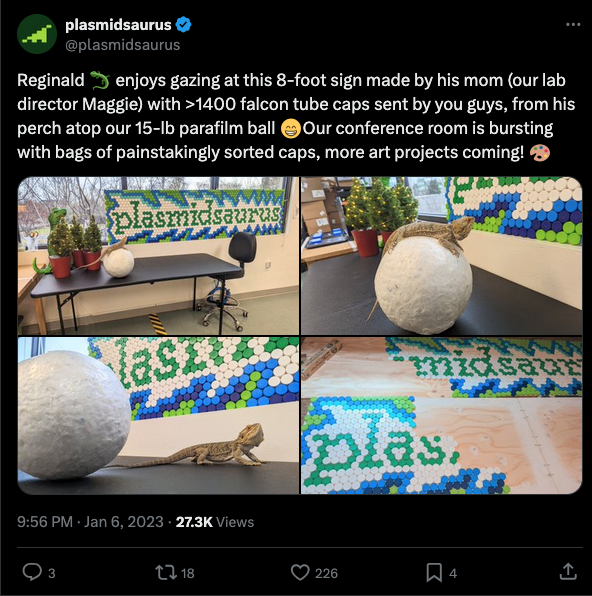
Another reason why this type of marketing works for them is because it aligns with their value proposition:
- Differentiation: Most biotech companies present themselves with a polished, professional, and often sterile image. Plasmidsaurus takes the opposite approach, embracing playfulness to grab attention and differentiate itself. This mirrors their core value proposition: while traditional sequencing services are often seen as expensive and slow, Plasmidsaurus offers a cheap, ultra-fast alternative. Their marketing reinforces this contrast, making them stand out both in branding and service delivery.
- Radical transparency: Their marketing style wouldn't work if their sales process were complicated. Instead, they ensure clear, upfront pricing and a frictionless ordering experience. If customers had to go through lengthy sales calls, the playful brand would feel misplaced, leading to frustration. Instead, Plasmidsaurus keeps it simple: order online, mail your sample, and get results in a day—no unnecessary hurdles.
- Bootstrapped and self-sustaining: Unlike many biotech startups reliant on investor funding, Plasmidsaurus is fully bootstrapped. This independence allows them to maintain their unique brand identity without internal pressure to conform to industry norms. Their marketing strategy fuels organic word-of-mouth growth, reducing the need for large advertising budgets. As a result, they can focus their resources on what truly matters: improving their technology and service—not appeasing investors who might not understand their unconventional approach.
Any other company with a more conventional past that tries to apply the same formula would just look awkward. I'm not saying a switch to unhinged marketing isn't possible, it's just that it takes real consistency and courage to apply it over time.
Do it once, and you're sure to get some backlash. Do it all the time, and it becomes part of your brand.
What Plasmidsaurus could do to go further
While Plasmidsaurus marketing is highly effective, I think they could further expand their reach by embracing it even more.
Here are just a few ideas I think could work for them:
- Make a dino mascot like the owl from Duolingo. They already kind of a mascot with the guy dressed as a dino in the videos, but they could make a drawing/animated version of him and use it for other purposes. This would create a recognizable symbol for their community and increase the effectiveness of their marketing. They could even create dinosaur-themed sequencing explainer videos using the mascot, which could be interesting to develop other channels and resources.
- Their LinkedIn page feels a bit empty compared to other social channels. I agree that LinkedIn is different from the rest, but a lot of people are now sharing science memes on LinkedIn, and I think this could be something Plasmidsaurus does there. Plus, this won't be their first foray into memes, as their X account was mostly meme-led in 2022:
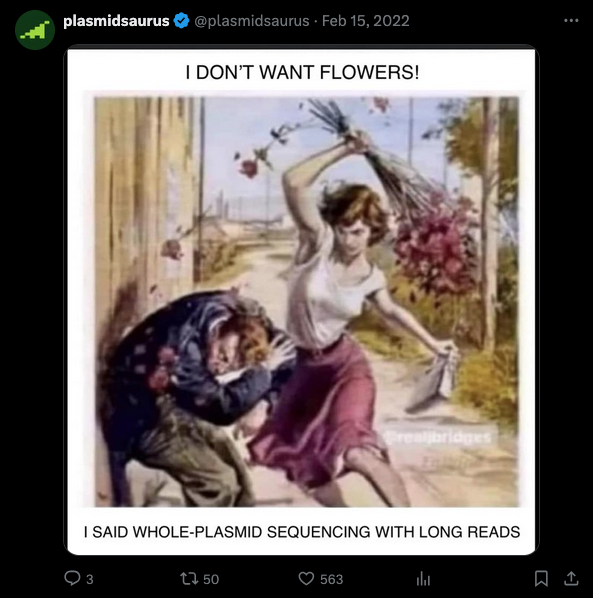
- According to the Plasmidsaurus marketing team, they don't run paid ads. I think this is a missed opportunity for growth. Running ads on the Meta platform and on Reddit ads could be particularly interesting for them to test as they already have a strong presence there, and many scientists are also active on these platforms. This could also be a good opportunity to lean into anti-marketing techniques with provocative and bold ad copies.
Those are just some ideas I collected while I wrote this case study, but in any case, Plasmidsaurus is already doing a great job with their marketing, and best of all, they prove that you don’t need to be serious to be taken seriously in biotech.
For life sciences companies looking to differentiate themselves, Plasmidsaurus offers a blueprint for unconventional success, but remember, unhinged marketing needs to be embraced by an organization to feel authentic and not like a failed attempt at being “cool”.
Do you have a case study you want me to cover next? Drop me a line.





